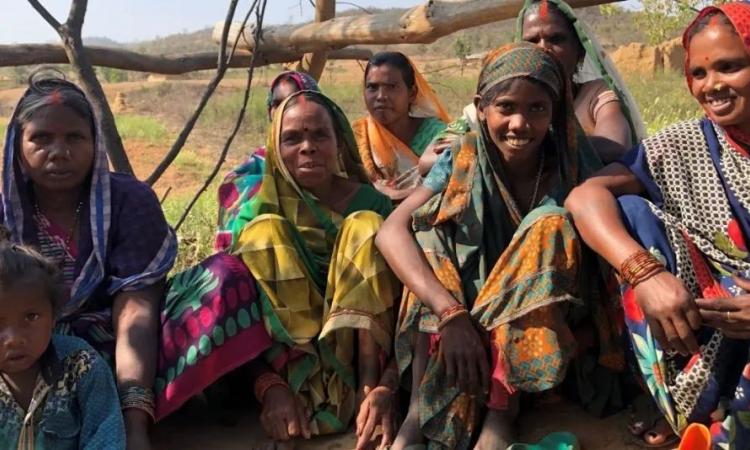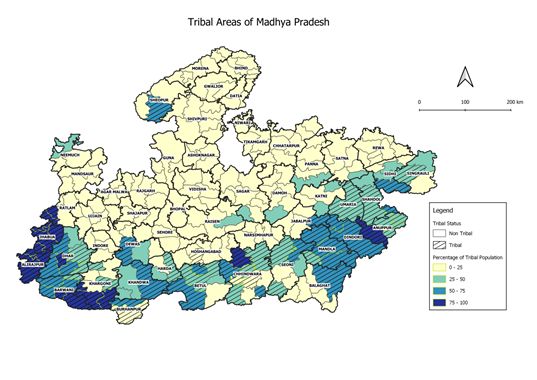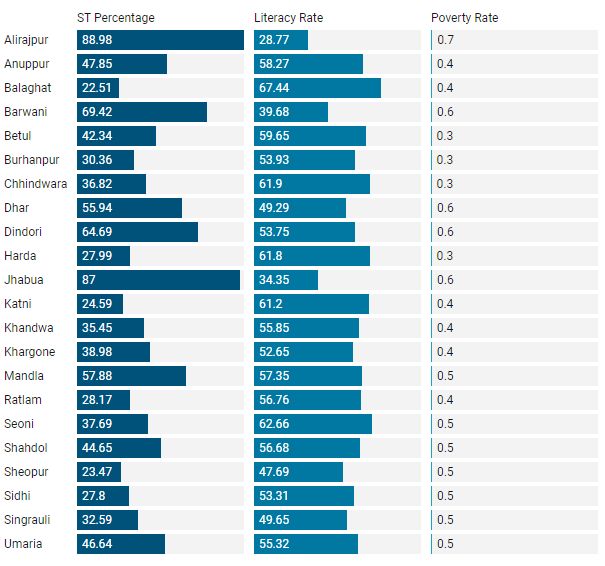
Madhya Pradesh has the largest tribal population of the country, and 21% of its population is comprised of Scheduled Tribes (STs) as per Census 2011. The state has 46 recognised Scheduled Tribes, spread across the 52 districts in the state. Of this, three are Particularly Vulnerable Tribal Groups (PVTG).
Major tribal groups in the state are Bhil, Gond, Kol, Kurku, Sahariya, and Baiga. These six tribal groups constitute more than 90 per cent of the tribal population of the state. The Bhil community comprises nearly 40 per cent of the total tribal population followed by the Gond tribe which constitutes another 34 per cent of the 1.53 crore tribal population.
Gonds are largely spread across eastern districts of Madhya Pradesh such as Mandla, Dindori, Anuppur, Umaria, Chhindwara, while the Bhils are found around western Madhya Pradesh districts of Barwani, Khandwa, Jhabua, Alirajpur and further extending into Rajasthan.
Scheduled Tribes live in all the districts of the state, however, the southern belt of the state, stretching neatly along Narmada River Basin, from Anuppur in the east to Barwani in the west houses most of the tribal population of the state.
There are 52 districts in Madhya Pradesh (as of May 2020), out of which in 22 districts, tribal population constitute more than 20% of the district’s population. Among these, in Alirajpur (89%), Jhabua (87%), Barwani (70%), Dindori (65%), Mandla (58%), and Dhar (56%), tribal population is more than 50% of the total population of the district.

A quick view of the differences in the tribal districts (with the proportion of tribal population more than 20%) and non-tribal districts (with the proportion of tribal population less than 20%) of the state shows that tribal districts are poorer and have lower literacy rate in comparison to the non-tribal districts and the state average.

Note: *As per Global Multidimensional Poverty Index 2015-16

Note: Literacy Rate is from Census 2011, while Poverty Rate is from Global Multidimensional Poverty Index 2015-16
In the case of irrigation, a comparison of the tribal and non-tribal districts reveals that the non-tribal districts have more cropped area under irrigation and a higher percentage of irrigated holdings than the tribal districts (see Table 3). Additionally, the level of groundwater development is significantly higher in non-tribal districts of the state in comparison to the tribal districts (see Table 3).

The data above suggests that the tribal population of Madhya Pradesh is at a disadvantage, especially when compared to the non-tribal population.
A state-level workshop for Madhya Pradesh titled “Integrated Water Resource Management in Tribal Areas of Madhya Pradesh - Challenges and Lessons” was held online to discuss a possible way forward considering the challenges that are present in tribal districts of Madhya Pradesh. A number of points emerged in the workshop as regards the challenges and opportunities related to integrated water resource management in the tribal areas of the state.
The tribal population in Madhya Pradesh is mostly settled in and around the forest and high altitude areas of the state. These physical conditions influence the socio-cultural context of the tribal communities. This combination of natural and social factors shapes the challenges that are specific to tribal people and tribal areas.
Rights and access
The majority of the tribal areas are forest areas that fall under the administration of the Forest Department. Tribals have been deriving their livelihoods mainly from these forest-based resources, however, their customary rights over forest land and their access to resources such as non-timber forest produce is vague due to the lack of proper survey, settlement and land record. Their rights to access water resources in the demarcated forest areas is ambiguous and they are treated as encroachers in the lands where they lived for millennia. Even after the enactment of the Scheduled Tribes and other Forest Dwellers (Recognition of Forest Rights) Act, 2006, which recognises the individual as well as community rights over forest resources the de facto rights and access remain limited.
Similar is the case with the Panchayat (Extension of the Scheduled Areas) Act, 1996 or PESA, which was enacted to ensure self-governance through gram sabhas for people living in scheduled areas. Though it promotes local governance by legally recognising the right of tribal communities in the scheduled areas to govern themselves through their own systems of self-government, its effective implementation continues to be a bottleneck due to the absence of rules. Both these acts (FRA and PESA) acknowledge the traditional rights over natural resources of tribals but their poor implementation by various state governments limits the forest rights of tribals.
Policies and programmes
Tribal areas have natural and social features that are distinct from non-tribal areas. Consequently, the policies and programmes designed for tribal areas need to be more decentralised and contextualised keeping a note of local needs, infrastructure and resources in the area.
Institutions
There is a lack of political representation from Scheduled Tribes at the state and central level. The gram panchayats that are reserved for tribal populations are often poorly supported. It is also observed that at the local level, the tribal department is weak in protecting the rights of tribals, especially inside forests. This lack of representation in decision-making at the policy level impacts tribal development and water management interventions in the tribal areas.
Technical aspects of water management
Water conservation rests on watershed management which works on rational utilisation of land and water resources for optimum and sustained production. The scale or level of the watershed in any specific management project, however, is debatable and has an immense range of scales. Watershed scale varies from as small as those of village ponds, to as large as the Ganga-Brahmaputra river basin.
There can be no single unit, applicable to all watershed management systems. Each unit is characterised by its particular natural environment and social condition that determines the success and failure of the management system. As such, it is significant but a challenging task to identify the scale of watershed management in a specific tribal area.
Research and monitoring of water management
Any programmatic approach towards water management requires data. However, there is a dearth of updated, and block (micro) level granular data related to tribal areas. The available data in most cases is outdated (by more than 5 years) and is available only at the most district level. The tribal areas, however, are more distinct at the block level. Consequently, the block serves as a better unit than the district for strategising and implementing programmes as well as policies for tribal populations.
Way forward
Tribal development is one of the key issues in Madhya Pradesh with 21 per cent of its population as Scheduled Tribes. A state-level comprehensive plan to work on this is necessary. A recommendation of the workshop was to compile the water management interventions, which have worked successfully in the tribal areas. As a follow-up, a compendium on best water management practices was developed for the tribal areas of Gujarat and Madhya Pradesh.
Additionally, policy studies focussing on tribal concerns in the state are required. The Tribal Livelihood Resource Centre, AKRSP(I) Netrang is working on a few such studies concentrating on issues of irrigation and drinking water for the tribal communities of the state. It is envisaged that such studies would contribute to a better policy ecosystem enabling tribal development.
This article is based on the State-level Workshop for Madhya Pradesh titled “Integrated Water Resource Management in Tribal Areas of Madhya Pradesh - Challenges and Lessons” held online on 8th June 2020. It was funded by the Axis Bank Foundation and organised by Aga Khan Rural Support Programme (India).
/articles/access-resources-eludes-tribals